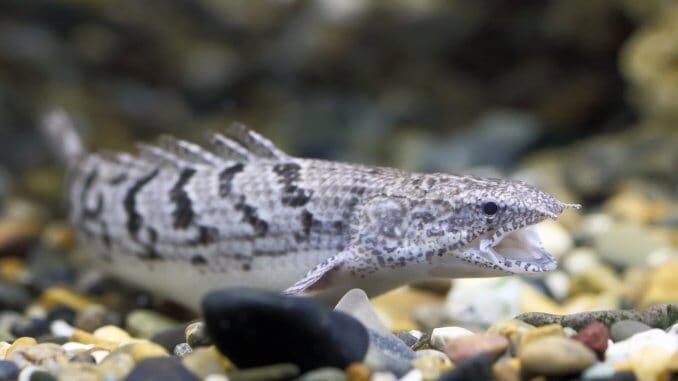
Bichirs have long eel-like bodies that will add a peculiar appearance to your tank.
They are very popular in the aquarium trade for their truly unique look and their bright coloration. You can even get albino variations, with bright red eyes and completely white skin.
These hardy fish might not be the easiest fish to care for, however, nothing beats having living fossils that look as old as the fish from the beginning of time, in your aquarium.
In this article, you will learn how to care for this fish including the best way to set up your tank, feeding habits, and much more…
TABLE OF CONTENTS
Bichir Facts & Overview
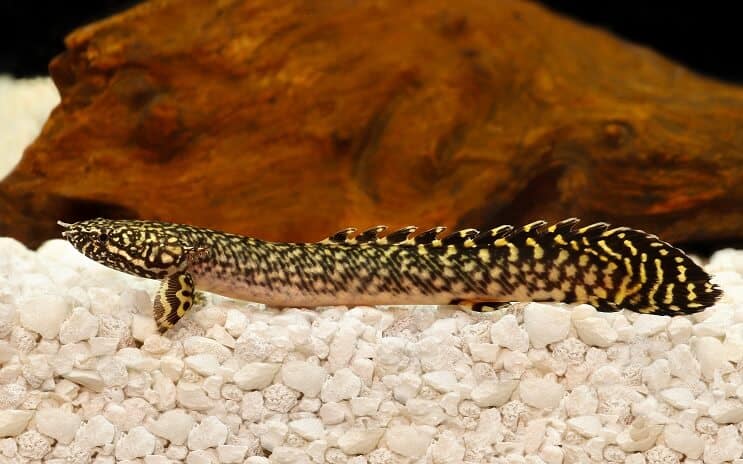
| Category | Rating |
| Care Level: | Intermediate |
| Temperament: | Semi-aggressive |
| Color Form: | Species dependent |
| Lifespan: | 15-20 years |
| Size: | 10-30 inches |
| Diet: | Carnivore |
| Family: | Polypteridae |
| Minimum Tank Size: | 90 gallons |
| Tank Set-Up: | Freshwater |
| Compatibility: | Large cichlids and catfish |
Bichirs are living fossils belonging to the Polypteridae family. They are a sister family of ray-finned fishes that have developed similar characteristics such as a pair of functional lungs and the Ampullae of Lorenzini (organs that can sense electricity, also known as electroreceptors).
They belongs to the genus Polypterus, which means ‘many wings’ – given due to their look. There are about 12 species in this genus recognized as Bichirs all from freshwater systems of tropical Africa.
These are quite large and aggressive fish that requires large tanks.
They are recommended for experienced aquarists as they require special attention with their carnivorous diet and tank conditions.
Most of the specimens you find available are caught in the wild – they are not commercially bred.
You should expect to pay anywhere from $20 to $110 for a good specimen. If you are buying juveniles it is impossible to distinguish between a male and female.
Typical Behavior
Bichirs are predatory fish, with a moderately aggressive temperament. They are problematic when kept with smaller size fish, as they will nip at their fins or even eat them. However, they seem to have no problems sharing their tank with larger fish.
These fish are bottom-dwellers and will spend most of their time near the bottom of the tank. They are nocturnal animals and prefer feeding during the night. They have poor eyesight and rely mainly on their other senses to find food.
They are peculiar-looking fish that can breathe air. They have paired lungs which help gas exchange in poorly oxygenated environments. They have two small openings on the top of their head called spiracles which they breathe through.
Another peculiar characteristic is that you will see them walking around on the substrate of your tank. Yes, you read correctly, they can walk! They can use their pectoral fins and tail to move around.
Interestingly, this has led to scientists trying to grow Bichirs on land which successfully adapted to ‘land-life’ giving insights on the first evolutionary steps of prehistoric animals living on land.
Appearance
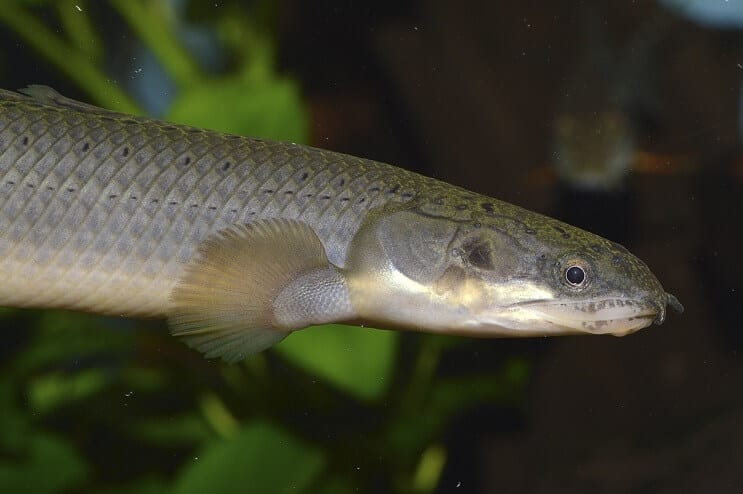
Bichirs are living fossils that resemble ancient-looking fish. They are one of the oldest living lineages leading to the bony fishes we know today and are the sister group of ray-finned fishes.
They have about 60 million years of independent evolution, retaining different characteristics from the common ancestor of all ray-finned fishes: lungfish and tetrapods.
An example of a common characteristic that these fish retained is their functional lungs but they also have developed some unique features such as the row of dorsal fins and scales.
There are 12 species of Bichirs in the Polypterus genus, all with similar characteristics. They have a slender snake-like body with multiple dorsal spines and fins. They also have visible nostrils with large paddle-shaped pectoral fins which are occasionally used to move around.
To compensate for their bad eyesight, they have protruding nostrils that can be directed around to help them pinpoint the source of the smell.
Whilst the difference between males and females is slim – females are usually larger in size while males have wider and thicker anal and dorsal fins.
- The Dinosaur Bichir, also known as Senegal or the grey Bichir, is among the smallest species (reaching about 14 inches). They have a long cylindrical grey-ish body with serrated dorsal fins and large pectoral fins used for locomotion. You will also find it in white, blue, or pink shades.
- The Ornate Bichir, also known as Polypterus ornatipinnis, has yellow pattern colorings on its back, body, fins, and head. Its base colorings can vary from dark brown to grey. This is one of the most popular and also one of the largest (24 inches in length).
- The Delhezi Bichir, also known as Polypterus delhezi has grey coloration with green or yellow spots. Its coloration makes it very popular.
- The Saddled Bichir, (Polypterus endlicheri) is one of the largest reaching up to 30 inches. This species has a lower jaw longer than the upper jaw, a characteristic that defines the different Polypterus species. They are whitish-yellow colored with dark vertical bands along the body.
- The Albino Bichir, is just an albino variety of the Dinosaur Bichir. They have white bodies, with red eyes.
Habitat and Tank Conditions
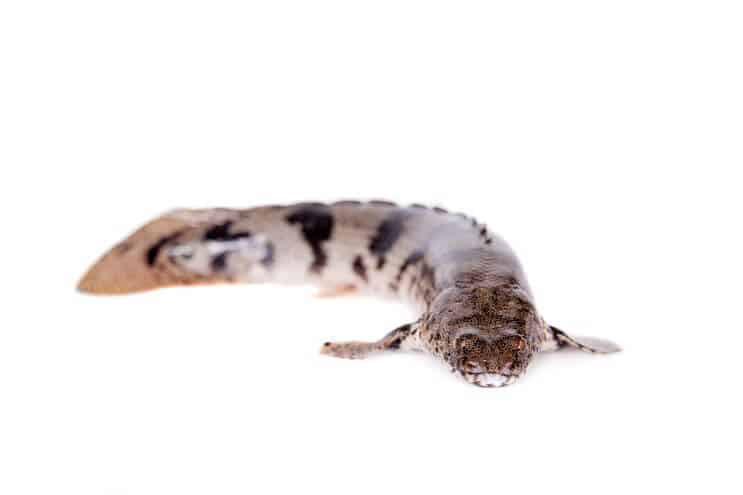
Bichirs are mainly found across freshwater environments in tropical Africa and the Nile River systems. They live in estuaries and floodplains with muddy waters and silted substrates.
As they have a good pair of functional lungs, they are very good at surviving in very poor oxygen conditions and low water habitats.
They can live in bogs and in low visibility habitats as they have a great sense of smell.
Tank Setup
They are quite large and sturdy fish that require specific water parameters and large tanks.
- They prefer softer waters
- Temperature 72-82°F
- Neutral pH (between 6.5-7.5)
Tank substrate is an important choice. Gravel can be an option, however, is not usually found in their natural environment. Sand is the best option.
They are not too fused about tank decoration, so you can add anything you prefer. Plants can be very useful, as they provide cover from light.
You should leave some air space above the water at the top of the tank to allow your fish to breathe. As they can survive in low oxygenated water quite easily, they don’t have specific filtration or aeration requirements. However just like any other tank they still need a good filtration system to get rid of the toxic chemicals produced from leftover food.
Don’t forget to put a tight cover on your aquarium as they will probably jump or crawl out of your tank.
Make sure to double check the water parameters for the exact species you decide to keep as different species have different water requirements.
What Size Aquarium Do They Need?
Bichirs are quite large fish and require at least a 90-gallon aquarium for an adult specimen.
Tank Mates
These fish are quite good tank mates providing the fish you put in the tank don’t fit into their mouth!
They usually do well with larger fish, so think Oscars, Blood Parrots, Flowerhorns, large Barbs, Knifefish, medium and large Catfish, and large peaceful African Cichlids.
Bichirs are quite slow-moving, so can have some problems with fast active tank mates stealing their food. As bottom-dwelling fish, they might starve as other fish can steal their food before reaching the bottom of the tank.
Remember though, they are predatory fish. So smaller fish and other non-fish inhabitants are discouraged as they will be eaten. They tend to hunt at night and by morning you might notice some of your smaller fish are missing.
Keeping Bichir Together
You can keep multiple Birchirs together. They will often form ‘poly piles’ and are quite sociable creatures. You’ll need a large aquarium, and all the fish should be a similar size.
Care
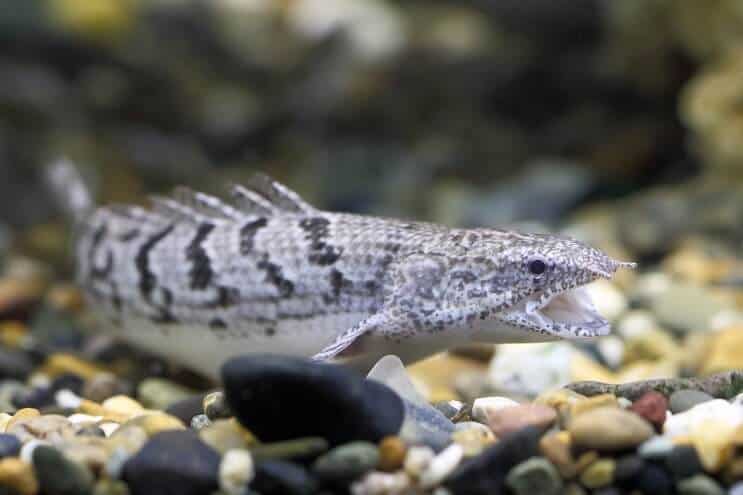
Bichirs are quite hardy fish and will not present many troubles. Try to provide the best environment possible and you will have happy and healthy fish.
They are susceptible to a few parasites such as internal flukes.
Skin and gills flukes are quite common, for example, Macrogyrodactylus polyptery which resembles fine threads on their skin. The fish might start rubbing and rolling around and can be treated using some medication.
Tapeworms are also quite common in wild-caught specimens as well as parasitic crustaceans, fungus, and bacterial infections.
Here the parasite lays eggs in the intestine of the host and they are eventually pushed out into the water.
The eggs are usually eaten by another crustaceans in turn and the process continues. As most fish, you find in the aquarium trade are wild-caught always quarantine your fish for at least 4 weeks before you add them to the main tank.
Diet
Bichirs are nocturnal predators. They are carnivorous fish and enjoy eating small vertebrates, crustaceans, insects, and other small fishes.
It is better to feed them with live food rather than pellets or artificial food.
Feeding them live food will bring out their natural predatory behaviors. They are slow eaters and you can feed them bloodworms, frozen shrimps, small fishes, and small pieces of meat such as ox heart, or earthworms.
They are nocturnal animals and prefer to be fed at night or when the lights are off. Let the baitfish sink to the bottom of the tank on the tank substrate.
Make sure that other tank mates don’t steal their food and starve them. If you decide to use sinking pellets or flakes, make sure there are high quality to reduce the risk of introducing potential sources of infection in the tank.
Even though they have bad eyesight, they are good predators relying on their sense of smell and their ability to sense electricity emitted from other objects/animals around them.
Breeding
Not much is known about breeding these fish in captivity. Generally, breeding Bichir is very difficult as different species require different water conditions, and these conditions are mostly unknown.
Some species (Polypterus delhezi and Polypterus senegalus) have been bred successfully, however not much is known about the conditions needed to induce spawning.
It is also very difficult to distinguish between males and females and almost impossible to distinguish with juveniles.
Are Bichirs Suitable For Your Aquarium?
Bichirs are old-looking fish that could make a great addition to your tank. These fish are literally living fossils that can adapt to live on land.
They are not fish for beginners as they require a certain attention to their care. They are nocturnal animals and quite hardy. If well cared for they can live for around 20 years.
There are about 10 species in this family. All are similar, though they each have slight differences from one another.
Did you know that certain fish can adapt to live on land? Leave a comment below…

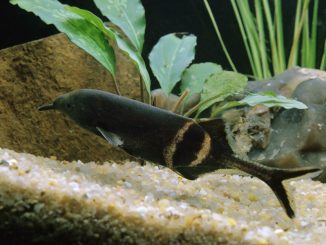
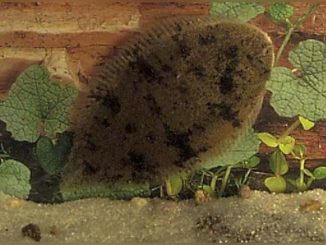
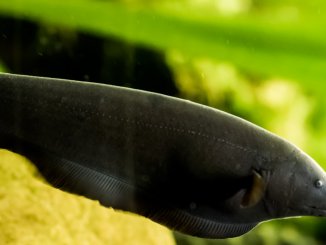
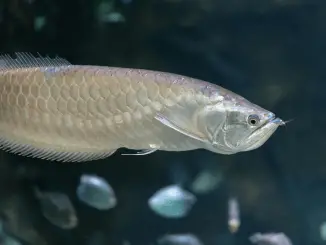
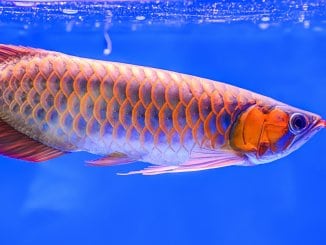
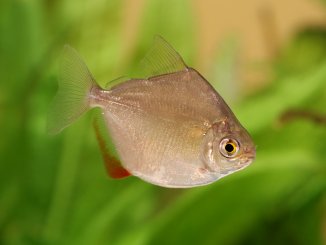
Very good information thank you x
My bichir has long feathery horns behind his/her gills. What are these?
Hi Robert, when Birchirs are young they have red feathery looking external gills. Is it possible this is what it is? Thanks, Robert
If you say so. So, they’ll go away?
Hi Robert, yes if this is what they are they’ll disappear as the fish matures. Thanks, Robert
Yes they will go away once more mature.
These are the external gills seen in young juveniles.
Its part of their gills. They will recede into the fish as it gets older. Its normal.
I’m setting up a new tank for my Bichirs, I am going for the most authentic habitat I can. My question is plant life, what species of plants would one find in their natural habitat?
Hi Mike, thanks for your question. Here are a few plant suggestion: Bolbitis heudelotii, Anubias, Vallisneria and Eleocharis. You can also include plenty of driftwood for them too. Thanks, Robert
This is some of the best and most accurate information on Polys I’ve seen, thanks Robert. Having kept them for over ten years I can confirm that if you follow these basic guidelines your little prehistoric monsters are going to be happy and long-lived.
I feed mine a mixed diet of live medaka (they love the hunt… the Polys that is), frozen bloodworm, small cat pellets and the occasional live shrimp treat.
Reports I’ve seen elsewhere of Polys not getting along together are inaccurate, if my experience is any guide. In fact, they tend to seek each other out and will ‘cuddle’ at times. They *can* get rowdy occasionally, but I see it as play; they never injure each other. But yeah… keep that top glass on tight, they can fly.
Agreed also on the bottom cover. Wood, plants, and I have a couple of failed pottery pieces transformed to tunnels in there too for when they want to chill. A word about the plants: I don’t think they really care what kind they are, but avoid delicate easily damaged greenery. In addition to the previously mentioned Poly parties they also like to ‘sit’ on the plants sometimes and will quickly ruin fragile specimens.
Scott
can I keep these fish with the gulper catfish
Hello. Is it ok to keep an Ornate Bichir by itself or do they do better in groups? I have three in my 150 gallon right now and are doing great. Each is about a foot long. I am planning to keep each of them solo in three 150 gallon tanks with other compatible fish. Will that be ok?
You said gravel is an option for substrate, actually bichirs can accidentally eat gravel rocks due to the way they eat and this will kill them. Sand is doable but I have mind in a bare bottom.
Can you make a aquarium for every species of bichir possible
Hi Robert,
Hope you can help. I recently purchased a saddled bichir. The fish previously belonged to one of the shop staff and he assured me that it was feeding well on carnivore pellets and mussel. I mentioned that it would be going in with some greedy fish but he told me that he’d had no previous problems with it competing for food. This particular specimen is approximately 12” long and is in a 500 litre tank with parrot fish, oscars, severum, arowana and synodontis. The bichir has been in the tank for a few days and has settled in well but doesn’t appear to be eating. It will sniff out food and comes out as soon as I put food in the tank. It approaches the food and will sit with its snout right up to it but then swims off. I’ve studied it carefully but never seen it take anything. My lighting is pretty subdued and doesn’t seem to put him off from investigating. I haven’t tried feeding with the lights off but should I be concerned? I’d rather return the fish than see it suffer! I’ve kept fish for 40 years and this is the first that I’ve owned that hasn’t fed within a few days.
Any advice would be greatly appreciated.
Thanks,
James
Can you have them in a bare bottom tank when fully grown?
It’s preferred to have them with some sort of substrate. Not essential but they will enjoy it more and it will encourage natural behaviors. Sand is also important for bringing out desired colors in your fish as they will change the environment. In the end it is up to you but sand or fine gravel will work best.